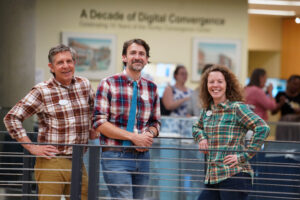
A University of Mary Washington building created to embrace the future is flashing back to its past.
A new Hurley Convergence Center (HCC) exhibit – “A Decade of Digital Convergence” – celebrates the first 10 years of a space meant to tap into emerging technology, bring a campus together and break ground.
“The Convergence Center introduced the UMW community to a wide array of technologies and opportunities that simply hadn’t existed before and in a format that didn’t exist at other schools at the time,” Chief of Staff and Vice President of Strategy Jeffrey McClurken said during the exhibit’s opening reception last month. Then special assistant to the provost for teaching, technology and innovation, McClurken served on the building’s planning committee and oversaw its opening.
Architectural renderings, video collections, before-and-after photos and more tell the story of the HCC’s quest to make state-of-the-art technologies and media tools accessible to the campus community, while fueling a sense of connection, collaboration and creativity. Since the center first opened in August 2014, tens of thousands of students have pushed through its transparent front doors in search of essentials – cameras and tripods, microphones and audio recorders – they need for their projects, and the training it takes to bring them to life.
“I’ll get emails every day from somebody with an idea of something they want to do,” Cartland Berge, director of the HCC’s Digital Knowledge Center (DKC), said on a 2016 video called “Creating a Buzz.” It’s one of several installations in the exhibit, on view in the Digital Gallery through the end of the year. “My job is to see … how we can use the equipment and facilities in the building to make what they’re thinking of into a reality.”




Originally dubbed the Information and Technology Convergence Center, before being renamed in honor of UMW’s ninth president, Richard V. Hurley, the four-story structure was strategically built to join Simpson Library via a hallway that hovers over Campus Walk. The HCC’s 77,000 square feet house the versatile two-story Digital Auditorium, along with Digital Learning Support, the Speaking and Writing Center and various IT offices, including the Help Desk. Other specialized spaces include video production studios, a vocal recording booth, a podcasting studio and a multimedia lab, plus conference rooms, team rooms and classrooms.
“The institution is one of the leaders in digital liberal arts, and this building was a way to try and move that forward by having facilities and people and support all in one place,” said Director of Digital Learning Support Jerry Slezak.
But the center has always been a work in progress, as depicted by an installation called “The HCC That Wasn’t.” Original designs called for a circular stairway, lobby “email bar” and outdoor fountain, all re-envisioned for various reasons. Plans for a motion capture lab transformed into the more versatile Charnoff Production Studio in recognition of Mary Washington alumni Mikhael Charnoff ’95 and Katherine Valentine Charnoff ’04. And a student gathering space across Campus Walk became a “Digital Café,” now home to For Five Coffee.
Photos show how present-day building spaces looked while under construction. A display case houses an assortment of artifacts – scrapbooks, pennants, buttons – forever preserved in the Simpson Library collection, thanks to the Digital Archiving Lab. “It’s a teaching space,” DKC Associate Director Shannon Hauser said of the building and its hands-on, forward-thinking approach.



An ode to the HCC’s two-story Media Wall – powered by a large-format projector and originally formed in a puzzle-piece shape – pays tribute to the visual content it’s featured throughout its existence, including public domain movies, animated GIFs and student submissions. The wall itself is displaying student art projects developed specifically for the building’s anniversary. Biology major Josiah Arnold, a senior, created a computer-generated video art piece that renders HCC locations from impossible viewpoints, and education and creative writing major Evelyne Breed, a sophomore, designed an LED light installation that winds around and “converges” on the Media Wall.
A miniature replica of the popular Console Living Room project that, at separate times, simulated living rooms of the ’80s and ’90s features a retro chair, chunky TV and Intellivision gaming console, thanks to the efforts of Communication and Digital Studies Associate Professor Zach Whalen. Even smaller, 3D-printed replicas of the HCC’s red “spin” chairs – a pair of swiveling seats that capture constant attention from curious students – are available for visitors to take home.
Through the past decade, the Hurley Convergence Center has welcomed outside events like the Electroacoustic Barn Dance, Open Education Resource Summit and Digital Pedagogy Lab. Each year it hosts UMW traditions like the Summer Science Symposium, Research and Creativity Day and the James Farmer Multicultural Center’s Civic Engagement and Leadership Summit. Open 24/7, it serves hundreds of students each day.
“It’s a place where people can dive into a passion and pick up the tools to pursue it,” Berge said. “They get the bug to create something they didn’t know was possible. This is a place where that sort of magic can happen.”


